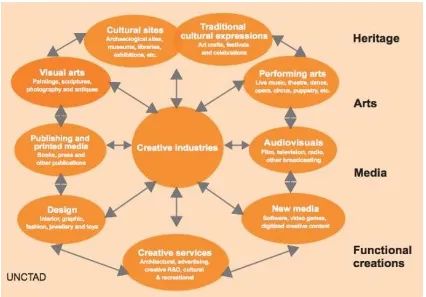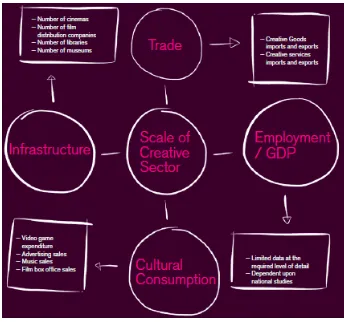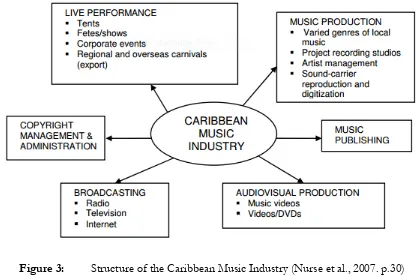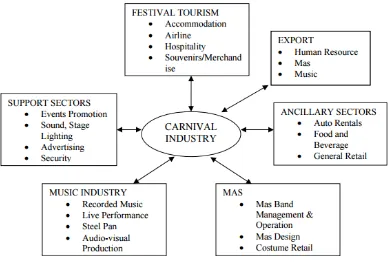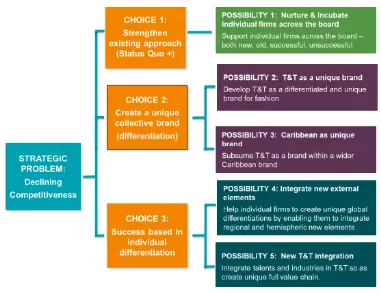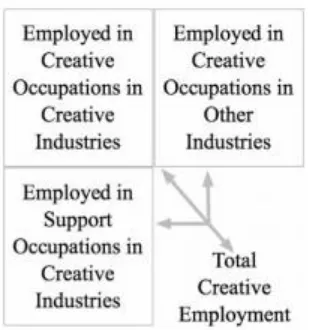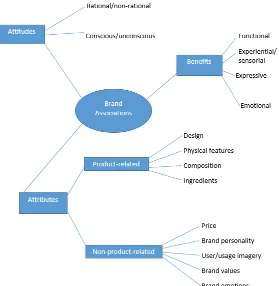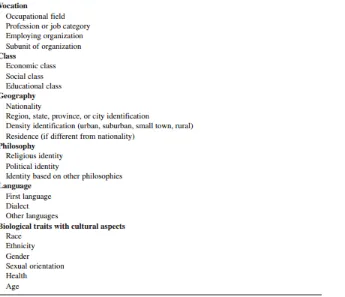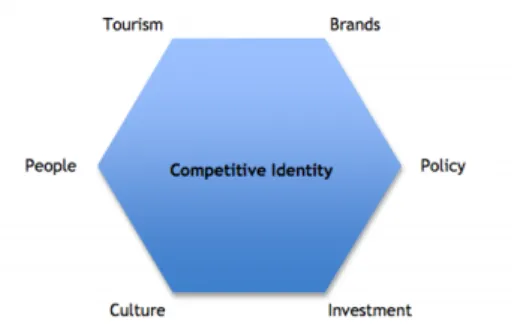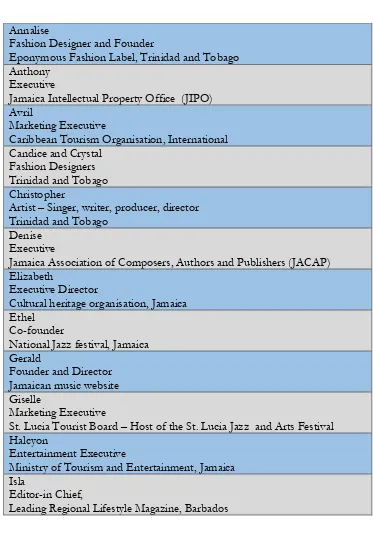warwick.ac.uk/lib-publications
A Thesis Submitted for the Degree of PhD at the University of Warwick
Permanent WRAP URL:
http://wrap.warwick.ac.uk/89580 Copyright and reuse:
This thesis is made available online and is protected by original copyright. Please scroll down to view the document itself.
Please refer to the repository record for this item for information to help you to cite it. Our policy information is available from the repository home page.
Brand in the Caribbean:
A Cultural Analysis of the Regional
Creative Economy
by
Gabrielle Deneise Ferdinand
A thesis submitted in partial fulfilment of the requirements for the degree of
Doctor of Philosophy in Creative Industries
University of Warwick, Centre for Cultural Policy Studies
i
Table of Contents
List of Abbreviations... v
List of Illustrations... vi
List of Tables... vii
Acknowledgments... viii
Declaration... ix
Abstract... x
Chapter One: Introduction... 1
1.1 Research background... 1
1.1.1 The Caribbean’s creative industries... 3
1.2 The research subject: aim, objectives and research questions... 6
1.3 The research rationale... 9
1.4 The scope of the research... 12
1.5 An overview of the Caribbean context... 15
1.5.1 The Caribbean’s territories... 15
1.5.2 The Caribbean’s colonial history... 17
1.6 The structure of the thesis... 19
Chapter Two: Researching the Region... 22
2.1 Identifying patterns in Caribbean creative economy research... 23
2.1.1 Industry mapping research... 25
2.1.2 Policy and trade research... 31
2.2 Exploring sector-specific industry research... 35
2.2.1 Music research in the Caribbean... 35
2.2.2 Festival research in the Caribbean... 39
2.2.3 Fashion research in the Caribbean... 45
Chapter Three: Theoretical Framework... 52
3.1 Redefining the creative economy as a symbolic economy... 53
3.2 Brand: A traditional perspective………. 60
3.3 Reimagining brand for the creative economy: A cultural approach... 62
ii
3.3.2 Brand as a medium for reconstructing cultural identity... 67
3.3.3 Brand as strategy... 70
3.4 Nation brands... 72
3.4.1 Understanding the nation brand... 72
3.4.2 Discussing Brand Caribbean and regional identity... 76
Chapter Four: Research Methodology... 83
4.1 Qualitative research... 84
4.2 Interview research... 88
4.2.1 Methodological limitations... 90
4.2.2 Contextual limitations... 92
4.3 Designing the interview study... 94
4.3.1 Sample design... 95
4.3.2 Interviewee database... 97
4.4 Conducting the interviews... 100
4.4.1 Crafting the interview guide... 101
4.4.2 Working with the interviewees... 102
4.5 Exploring the data analysis process... 104
4.6 Outlining ethical concerns... 108
4.7 Reflecting on my role as researcher... 110
Chapter Five: Brand and Cultural Policy in the Caribbean... 114
5.1 The policy landscape in the Caribbean... 115
5.1.1 An introduction to national policy frameworks... 115
5.1.2 An introduction to regional and transnational policy frameworks... 120
5.1.3 An overview of current legislation... 122
5.2 The presence and absence of brand discourse in policy frameworks... 128
5.2.1 The Regional Cultural Policy of the Caribbean Community... 129
5.2.2 The Draft National Cultural Policy of Trinidad and Tobago... 131
5.2.3 The National Cultural Policy of Jamaica... 133
5.2.4 The National Cultural Policy for Barbados 2010 and The National Strategic Plan of Barbados 2005-2025... 137
iii
Chapter Six: Exploring Brand within the Caribbean Creative Economy... 147
RQ 1: How is brand understood, constructed and used by cultural producers within the Caribbean creative economy? 6.1 Unpacking the term ‘brand’... 148
6.1.1 Definitions of brand in the Caribbean... 148
6.1.2 Brand as a ‘buzzword’... 152
6.2 The construction of brand(s)... 155
6.2.1 The process of brand-building... 155
6.2.2 Brand-building across creative sectors... 158
6.3 Brand in practise... 164
6.3.1 Brand as protection: A defensive approach... 164
6.3.2 The role of the ‘metabrand’ and collaborative frameworks... 169
RQ 2: How does brand influence the dynamics of the Caribbean creative economy? 6.4 Brand and Creativity... 176
6.4.1 Creativity in the Caribbean framework... 176
6.4.2 Brand expectations and creative production... 180
6.4.3 Creativity and strategic decision-making... 184
6.5 Brand and Value... 187
6.5.1 Perspectives on brand value... 190
6.5.2 Locality and brand value: The indigenous vs. the imported... 195
6.5.3 Redefining brand value within a colonialist framework ... 198
Chapter Seven: Understanding Brand Caribbean... 211
RQ 3: What is ‘’Brand Caribbean’, as defined within the global creative economy framework? 7.1 Defining Brand Caribbean... 212
7.1.1 The intertwining of brand and environment... 213
7.1.2 Brand as an articulation of the lifestyle... 218
7.1.3 Brand personality... 223
7.2 Exploring issues around Caribbeanness and authenticity... 228
7.2.1 Identifying the ‘Caribbeanness’ in Brand Caribbean... 228
iv
RQ 4: What are the relationships between national brands and cultural identities and Brand Caribbean?
7.3 Brand Caribbean: A composite of diverse national brands... 236
7.3.1 National identity and Brand Caribbean... 236
7.3.2 The role of the people in Brand Caribbean... 240
7.4 Regionalism and the competitive spirit... 245
7.5 Regional integration and collaboration... 250
RQ 5: What role does Brand Caribbean play within the global creative economy? 7.6 Brand Caribbean in the global marketplace... 255
7.7 Exploring brand success... 258
7.7.1 Defining brand success... 258
7.7.2 Discussing the ‘It sells itself’ concept... 261
Chapter Eight: Conclusion... 269
8.1 Conclusions about brand in the Caribbean creative economy... 270
8.2 Conclusions about Brand Caribbean... 277
8.3 Implications for future research... 284
Bibliography... 287
Appendices... 336
A. Models of the creative economy... 336
B. Strategic recommendations and action plans put forward by the Caribbean Regional Negotiating Machinery (CRNM)... 337
C. Photographs depicting traditional Carnival masquerade costumes... 339
D. Photographs depicting contemporary Carnival masquerade costumes... 342
E. List of Carnivals produced by the Caribbean diaspora... 345
F. Interviewee database... 346
G. Sample interview guide for music industry stakeholders... 355
H. Sample transcript... 357
v
List of Abbreviations
CARICOM The Caribbean Community
CISAC The International Confederation of Authors and Composers Societies Creative TT Trinidad and Tobago Creative Industries Company
CRNM Caribbean Regional Negotiating Machinery CTO Caribbean Tourism Organisation
ECLAC Economic Commission for Latin America and the Caribbean JIPO Jamaica Intellectual Property Office
JTB Jamaica Tourist Board
UNCTAD United Nations Conference on Trade and Development UNDP United Nations Development Program
UNESCO United Nations Educational, Scientific and Cultural Organization WIPO World Intellectual Property Organization
WTO World Trade Organization
vi
List of Illustrations
Figure 1: UNCTAD Classification of Creative Industries ... 2
Figure 2: Creative Industries Data Collection... 30
Figure 3: Structure of the Caribbean Music Industry ... 36
Figure 4: Structure of the Carnival Industry... 41
Figure 5: Strategic Choices and Possibilities for the Trinidad and Tobago Fashion Industry... 48
Figure 6: The Creative Trident... 54
Figure 7: Types of Brand Associations... 64
Figure 8: Components of Cultural Identity... 68
vii
List of Tables
Table 1: Contribution of Copyright Industries to GDP and
viii
Acknowledgements
ix
Declaration
x
Abstract
1
Chapter One: Introduction
1.1
Research background
This thesis explores brand as a dimension of the Caribbean’s creative economy. It is therefore essential to first lay the groundwork and introduce this economy and the industries that form it. The creative economy “is an emerging concept dealing with the interface between creativity, culture, economics and technology in a contemporary world dominated by images, sounds, texts and symbols” (United Nations Conference on Trade and Development, 2013). A young field, compared with other academic disciplines, it evolved out of discourse around arts, creative industries and creative cities (Landry and Bianchini, 1995; DCMS, 1998) and gained wider popularity following the publication of John Howkins’ seminal text The Creative
Economy: How people make money from ideas (2001). It has since continued to be at the centre of
numerous debates regarding structure, governance, geography, economic systems, political economies, policy frameworks, labour and socio-cultural discourse (Caves, 2000; Flew and Cunningham, 2010; Florida, 2012; Hesmondhalgh, 2009; O’Connor, 2010; Pratt, 2012, Throsby, 2001). In fact, to date even the term ‘creative economy’ still proves problematic for some academics, however given the limited aims of this thesis it will be used as it the term favoured by Caribbean industry stakeholders, policy makers and academics alike.
This creative economy is built around what is now more popularly referred to as the cultural and creative industries (CCIs).1 According to the United Nations Educational, Scientific and
Cultural Organisation (UNESCO), the CCIs are “sectors of organised activity whose principal purpose is the production or reproduction, promotion, distribution and/or commercialisation of goods, services and activities of a cultural, artistic or heritage-related nature” (UNESCO,
1 It is important to note that while the terms ‘cultural industries’ and ‘creative industries’ each have their
2
[image:14.595.92.518.273.570.2]2016a). Still, in academic and professional circles much contention continues to surround the discussion around which sectors can be classified as creative industries. At the centre of this debate are various industry models of the creative industries including the United Kingdom’s Department of Culture Media and Sport (DCMS) model (Department of Culture Media and Sport, 2001), the symbolic texts model (Hesmondhalgh, 2013), the concentric circle models (Throsby, 2001) and the World Intellectual Property Organisation copyright model (WIPO, 2015) all of which use different metrics and classification.2
Figure 1: UNCTAD Classification of Creative Industries (UNCTAD, 2010, p.8) For this thesis, the creative industries will be defined using the United Nations Conference on Trade and Development (UNTCAD) model of classification as it is one of the few to include the heritage sector, allowing the inclusion of the festival industry, a key driver of the Caribbean creative economy. As Figure 1 (above) illustrates, this model identifies four core
3
sectors: heritage, arts, media and functional creations, under which numerous creative activities are incorporated.
Today, the creative industries continue to grow globally at significant rate, with the Cultural
Times 2015 Report estimating that in 2013 they generated US 2,250 billion dollars in revenue
worldwide (The International Federation of Societies of Authors and Composers, 2015). However, the global creative economy is by no means homogenous and in the Caribbean while some regional creative sectors are flourishing, others have not necessarily seen the same growth.
1.1.1
The Caribbean’s creative industries
The creativity that flows from the Caribbean is abundant and is reflected in the region’s emergent creative economy and its continued contribution to the global creative economy. As esteemed regional economist Norman Girvan points out “…this region has been the source of a creative outpouring in music, art, and culture that is out of all proportion to the modest population of the islands and related mainland”(Girvan, 2000, p. 6). The Caribbean certainly makes quite a striking impact, especially considering its relatively small size. Take for example the music sector, where the Caribbean has given the world the only acoustic instrument invented in the 20th century – the steelpan. The region has also birthed numerous musical
4
Apart from music, the region also boasts thriving theatre, visual arts and fashion design sectors. In the literary field, the region has also notably bred Nobel Laurates and acclaimed authors the likes of Sir Arthur Lewis, VS Naipaul, Derek Walcott and C.L.R James (Dance, 1986). However, the Caribbean has truly built its global reputation due to its thriving festival sector, boasting a continually expanding repertoire of festivals devoted to celebrating Caribbean music, culture, food, religion and sport. In Trinidad and Tobago there is the Trinidad Carnival, the Tobago Jazz Festival, the Tobago Blue Food Festival, the Tobago Heritage festival, Great Fete Weekend, and Divali Celebrations to name a few. Similarly, Jamaica hosts the Jamaica Carnival and Reggae Sumfest (a follow-up to the iconic Reggae Sunsplash), while Barbados has developed a huge following for its annual Crop Over carnival celebrations. These festivals are seasonal events, as there are often hundreds of smaller events and fêtes (parties) that take place before and after the grand finale street parades, with each island being well known for its uniquely flavoured events.3 Still, the reach of Caribbean
festivals has extended far beyond the region since the diaspora have taken these festivals across the globe. Today, the world’s largest festivals such as the Notting Hill Carnival in London, the West Indian American Day Carnival Parade (also known as the Labour Day Parade) in New York and the Caribana festival in Toronto are some of the largest celebrations of Caribbean culture, and earn their host nations approximately 93 million pounds sterling; 300 million US dollars and 200 million Canadian dollars respectively (Nurse, 2007; London Development Agency. 2003).
Now while it is easy to identify the Caribbean’s impact from a sociocultural perspective, ratifying it through data remains a challenge. Research conducted by the Economic Commission for Latin America and the Caribbean (ECLAC), estimates that CARICOM
3 Other major regional festivals include the Grenada Spicemas; Grenada Regatta; St. Lucia Jazz and Arts
5
countries account for approximately 0.01% and 0.04% of world trade in creative goods and creative services respectively (ECLAC, 2012, p. 35). However, these figures are estimates at best and more detailed regional statistics are even harder to find. As Chapter Two will illustrate, there is little recent statistical data on the cumulative economic impact of the Caribbean’s creative industries. In 2007, Jamaica was the first to conduct a full-scale investigation to track the contribution of the copyright industries,4 with figures showing that
the sector earns 4.8 percent of the island’s Gross Domestic Product (GDP) and accounts for a 3% share of total employment across the island (James, 2007). In 2012, a similar WIPO study on Trinidad and Tobago showed that the copyright sector also represented 4.8% of the islands GDP, more than agriculture and hotels (James, 2012). However since these reports there have been few further attempts to track creative industry development, as regional government investments have been channelled toward alternative sectors that have been deemed as having more of a direct impact on national development. Yet recently as a result of the region’s economic downturn5 and mounting national deficits, many island nations have
been searching for new avenues to diversify their economies and the creative industries have emerged as a favourable option.
4 The WIPO frames the creative industries as ‘copyright industries’ (cf. WIPO. 2015).
5 For more on the regional economic downturn see the International Monetary Fund’s World Economic
6
1.2
The research subject: Aim, objectives and research questions
This thesis introduces brand into the discourse surrounding this renewed interest in the region’s creative industries. As this subject has never before been researched within the Caribbean context, this thesis aims to argue that brand is in fact a critical component of the creative economy and in so doing present a new and alternative framework that can be used for cultural analysis across the regional creative economy. While brand has been described as “a term that has become so overdefined that its meanings are variable” (Stern, 2006, p. 216), for the purposes of this thesis a good starting point is interpreting brand as “a name that symbolises a long-term engagement, crusade or commitment to a unique set of values, embedded into products, services and behaviours, which make the organisation, person or product stand apart or stand out” (Kapferer, 2012, p.12). However, it is important to note that this research intends to demonstrate that this definition of brand must be expanded in order to reflect the idiosyncrasies and intricacies that characterise the creative economy.
7
In keeping with the overarching aim of using brand as an alternative means of examining the Caribbean’s creative industries, three (3) key objectives have been identified by the researcher:
i. To explore the way brand is crafted, framed and reproduced by cultural producers. ii. To describe how brand (interpreted as symbolic, linguistic, visual and commercial)
impacts the dynamics of the Caribbean creative economy.
iii. To examine Brand Caribbean in the context of issues pertaining to the global creative economy.
In contextualising these objectives, it is important to state that this research is not an exclusive study of the creative economy, nor is it an exclusive study of brand, and as such does not take an economics-based approach to the creative economy or a business-focussed approach to brand. Instead this thesis should be seen as an inductive study of the cultural dimension of the creative economy, focusing on what this thesis argues to be a core factor – brand. This alternative approach allows the research to explore the relationships between brand and cultural production, experience, meaning, identity, creativity, value, history, global exchange and the like. In so doing, it is able to generate new knowledge about the dynamics of the regional creative economy, the frameworks that surround it and the role that brand plays within both.
8
and if this value is recognised by regional cultural producers. The thesis also studies Brand Caribbean’s larger role within the global creative economy, as well as examining the interplay between Caribbeanness, national brands and cultural identity. The abovementioned is of course encapsulated in the thesis’ five (5) core research questions:
RQ 1: How is brand understood, constructed and used by cultural producers within the
Caribbean creative economy?
RQ 2: How does brand influence the dynamics of the Caribbean creative economy?
RQ 3: What is the ‘Brand Caribbean’, as defined within a global creative economy
framework?
RQ 4: What are the relationships between national brands, cultural identities and Brand
Caribbean?
RQ 5: What role does Brand Caribbean play within the global creative economy?
9
1.3
The research rationale
One of the primary catalysts behind this research is the fact that the Caribbean’s creative economy is an underdeveloped and under-resourced field. As Chapter Two will illustrate, the Caribbean has not invested much in creative economy research, in part because the region’s governing bodies do not fully recognise the value of the creative industries as agents for social, cultural and economic development. Consequently, there is a critical need for research like this which through its exploration of themes related to national identity, regional integration and cultural development, can further highlight the cultural contribution of the regional creative economy. In so doing, this thesis can further articulate the value of the creative industries and add to the growing pool of knowledge on the various social, cultural and economic offerings of the regional creative economy.
Still, even as the scholarship around the regional creative economy slowly expands, the research in this thesis has identified a gap. To date, most regional academic creative economy research produces macro-level analyses where the industry is charted in terms of economic, industrial and political factors. This research is usually conducted within an economic framework, with the focus on structure, functionality, trade and economic remuneration. Now while this economic perspective provides fiscal and commerce-driven insight, it often overlooks sociocultural dynamics. As such, there was a clear need to further develop the regional canon of creative economy research utilising a more culture-centered approach, where researchers do not just focus on the economy aspect of the creative economy, but also on the cultural.
10
thus encouraging a much more culturally-driven analysis. As a result, this thesis veers away from the traditional practise of viewing the creative economy as a space for the trading of goods and services, recognising that it is also a symbolic economy where symbols and meaning are negotiated and exchanged (Lash and Lury, 2007). Re-conceptualising the creative economy to view it as a symbolic economy shapes the direction and scope of this thesis both in term of the methodological processes used and the lens through which the data collected is assessed. Consequently, it ultimately offers alternative metrics with which to assess the regional creative economy.
Why Brand?
This research uses brand as a theoretical framework through which to gain a greater understanding of the Caribbean, its creative economy, its brands and their larger roles within the global marketplace. The decision to focus on brand was taken in part because the study would be the first to position brand as a central mechanism in the regional creative economy, and as such the thesis would produce original research. Using brand as a theoretical framework offered a unique lens with which to examine, understand and potentially offer explanations surrounding the workings of the Caribbean’s creative industries with respect to organisation, production, distribution and consumption.
11
the negotiations that cultural producers engage in, as well as the overall development of the regional creative economy.
In addition to the above, the success of global branding initiatives also provided further incentive for studying brand on a national and regional scale. To date, several nations have adopted branding campaigns as a means of propelling their national sectors. Take for example, Singapore’s nation branding campaign that was launched in 1996 and has arguably contributed to the nation’s ascent to its current position as Asia’s top city and the best city worldwide for investment potential, all in spite of the nation’s small size and it’s lack of natural resources (Brand Finance, 2015; Singapore Government, 2015). Likewise, in 2009 South Korea launched the Presidential Council on Nation Branding in a bid to “expand the contribution to international society; disseminate the value of traditional culture, strengthen global communication and pursue nationwide integration (Presidential Council on Nation Branding, 2016). Brand South Africa has also seen some success in using their campaign as a vehicle to further national development through research into critical areas such as domestic perception, nation brand reputation, global competitiveness, investor perceptions and media reputation (Brand South Africa, 2015).
On a smaller scale, brand campaigns have also proven successful for cities such as Seoul, Rio de Janeiro and Dubai, currently listed as 5th, 7th and 10th respectively on the ‘Guardian Cities
12
Ultimately, if the Caribbean creative economy needs to negotiate a stronger position within the global economy then this research suggests that brand provides an avenue to do so. In illustrating this, it is hoped that this thesis will prove of service to industry stakeholders and cultural producers across all sectors, helping them grasp a deeper understanding of brand and its position within the regional creative economy. It is also hoped that the insights provided here will assist the region’s cultural policy makers in reshaping their ideas around the Caribbean creative economy and allow them to make to make more well-rounded and informed decisions regarding much needed sector development.
1.4
The scope of the research
To start, it is first important to clarify the scope of the term ‘Caribbean’. Within this thesis, the term Caribbean will be used to refer to Caribbean Community (CARICOM)6 member nations
only. Presently, CARICOM has fifteen (15) member states: Antigua and Barbuda; the Bahamas; Barbados; Belize; Dominica; Grenada; Guyana; Haiti; Jamaica; Montserrat; St Kitts and Nevis; St. Lucia; St. Vincent and the Grenadines; Suriname and Trinidad and Tobago. It also has five additional associate members Anguilla, Bermuda, British Virgin Islands, Cayman Islands, and Turks and Caicos Islands.7
This thesis has chosen to focus on CARICOM nations since apart from the obvious geographical proximity, they also share several commonalities. Firstly, they all have a similar historical narrative and as such their cultural influences, social structures and the challenges and opportunities that stem from both are similar across the islands. Secondly, the fact that they have similar political structures and share a central governing body means that the
6 CARICOM is the region’s primary governing body and its principal objectives include: “improved standards
of living and work; full employment of labour and other factors of production; accelerated, co-ordinated and sustained economic development and convergence; expansion of trade and economic relations with third States; enhanced levels of international competiveness; organisation of increased production and productivity” (CARICOM Secretariat, 2016).
13
countries are also formally connected. Thirdly, since this thesis focuses on Brand Caribbean, it is important to be able to look past individual island states and see the region as a singular entity, and in that regard CARICOM remains the primary organisation that connects these nations and thus validates the communal identity that they all share. In summary, the fact that these countries all share intertwined historical, political and cultural backgrounds means that there are similarities amongst them that can form the basis for generalisations and as such for the purpose of this research the CARICOM relationship is extremely significant.
In the interest of feasibility and practicality, of the fifteen CARICOM member countries, this thesis will focus primarily, though not exclusively, on three nations: Barbados, Jamaica and the twin island nation of Trinidad and Tobago. Due in large part to their wealth and size, these three islands have dominated CARICOM since its inception and have remained the most influential to date. These territories were also specifically selected because they have the strongest national creative economies, with research showing that these three nations produce the lion’s share – sixty-six percent (66%) of regional creative goods that reach the global market (ECLAC, 2012, p.38). As such, these three nations provided the most data and opportunities for researching the region’s creative sectors, given their relative wealth, infrastructure and cultural production capabilities.
14
Secretariat Community, 2010). Similarly the Trinidad and Tobago Foresight Project,8 also
identified these three national sectors as the ‘best bets’ for national investment (National Institute of Higher Education, Research, Science and Technology, 2007). To date, festivals and music remain the highest economic earners for the Caribbean’s creative economy, with estimates showing that the recording industry in Jamaica earns US 80 to 100 million in foreign exchange, while the live performance industry in Trinidad earns 50-60 US million and the festival industry in Barbados earns 20-25 million (Nurse, 2006). Also, as the fashion sector continues to grow but is not yet a top earner, its inclusion in this thesis presents the opportunity to discuss the experiences aligned with the earlier stages of a sector’s development. Furthermore, the analysis of these three diverse sectors allows for a broad overview of the creative economy, since each sector is representative of one of the core creative industry strains: media; arts; functional design and heritage.9 As such, it is clear that
these three sectors were best suited for developing a series of penetrating insights of the regional creative economy.
Finally, in outlining the scope of this thesis, it also important to note that the focus of this research is cultural producers and not cultural consumers. Given that brand is frequently approached from the consumer’s perspective, focusing on cultural producers was a strategic decision taken to delineate this work from the heavily saturated field of consumer brand research. Also, since consumption is very difficult to track and assess, particularly in an informal market such as the Caribbean, focusing on the consumer relationship with brand would have been particularly challenging given the region’s lack of infrastructure. It also seemed much more beneficial to study cultural producers since this group of stakeholders
8 This project was aimed at identifying avenues for growth and investment for multiple national sectors.
9 See the Creative Economy Report 2010 for the UNCTAD classification of the Creative Industries (UNCTAD
15
possess the agency to affect change and ultimately influence the position of regional creative economy within the global marketplace.
Overall, all the decisions taken in mapping out the scope of this thesis were strategically made in order to ensure that the field was manageable yet diverse enough to be able to produce a critical analysis of the regional creative economy .
1.5
An overview of the Caribbean context
To fully understand the context within which this research is conducted, the reader must be aware of a few distinct features of the Caribbean that have a direct impact on the workings of the regional creative economy. Thus, this section offers a brief overview of the territories, their economic standing and their rich history, so that the reader may have a full appreciation of the research framework.
1.5.1 The Caribbean’s territories
From a geographical perspective the Caribbean, also known as the West Indies, refers to the area east of Central America and north of South America (between 10°and 26° North) within the Caribbean Sea10. In studying the Caribbean, it is important to first appreciate the
topography of the region since the physical landscape and the space that separates the islands play a significant role in the creative economy, particularly in terms of shaping cultural production and cultural distribution. Secondly, it is important that the reader recognises that in reality, the term ‘Caribbean’ is an umbrella term for fifteen separate nations. Thus, while the term ‘Caribbean’ does generate connotations of a collective, in reality the term is a geo-political paradigm that has been created to blanket a region of diverse nations. Acknowledging that the Caribbean is defined by a political framework, more so than some sort of intrinsic
10 However, as aforementioned, within the context of this thesis the Caribbean refers only to CARICOM’s
16
connection, is an important step for helping reader to understand the tensions that face a regional economy, as these tensions have several implications, many of which are evident throughout this thesis.
Additionally it must be noted that across these Caribbean nations, the national economies differ significantly, particularly in terms of resources and wealth. According to the 2016 World Bank GDP per capita report, the richest of the CARICOM Caribbean nations are the Bahamas (GDP 22,217.5 US dollars), closely followed by Trinidad and Tobago, St. Kitts and Nevis and Barbados. However there is a huge gap between the earnings of these nations and the likes of Haiti (GDP 824.2 US dollars) Guyana, Belize, and Jamaica, which constitute the region’s poorest territories (World Bank, 2016). While these wealth disparities are owing to many factors, the richest regional economies are usually those with natural resources, which include natural gas, petroleum, asphalt, hydropower, beaches, flora and fauna etc. However, as some of these resources are more commercially valuable and easier to monetise, it is not just a nation’s reserves of natural resources but the economic viability of those resources that become key determinants in the organisation of its economy with respect to trade, production, distribution and consumption.
17
mediation of discrepancies in national wealth plays a crucial role in the organisation and development of the regional creative economy.
1.5.2 The Caribbean’s colonial history
Most territories in the Caribbean share a similar historical narrative, and the region’s colonial history is particularly relevant to this research. Prior to colonial inhabitancy, the Caribbean had vibrant indigenous populations of native Amerindians who had migrated from Latin America and brought with them unique linguistic, artistic, and spiritual practices, traces of which are still evident in contemporary Caribbean societies. However, on October 12, 1492 Christopher Columbus re-discovered the region and the resultant colonisation of the islands lead to mass expulsion of locals and genocide. Later, when the French, British and Dutch forces also entered the region, frequent wars ensued as the Europeans fought over the islands, and as a result the islands switched hands between European monarchs numerous times.11
The turn of the seventeenth century heralded the sugar revolution, which was characterised by “a shift from diversified agriculture to monoculture, from small to large scale farming units, from low to high value output, from sparse to dense settlement patterns and from free labour to slavery” (Higman, 2011, p. 98). In order to support the sugar economy, millions of Africans were shuttled to the region via the transatlantic slave trade to work on plantations and agricultural estates. During this era the region flourished economically though socially many slave rebellions and uprisings created a tense and uneasy climate, as it proved increasingly difficult to navigate “the boisterous, violent society of struggling settlers, prospering planters, exasperated officials, machinating merchants, suffering slaves and ambivalent free persons of colour” (Knight, 2012, p. 63).
11 Take for example the island of St. Lucia which changed hands over fourteen times between the Spanish,
18
Meanwhile in Europe, movements for the abolition of slave labour were growing, fuelled by both human rights and religious principles. Slavery was eventually abolished in 1834 in the British colonies, in 1848 in French and Danish Colonies, in 1863 in the Dutch colonies and in 1888 in the last of the Spanish colonies. Following the abolition there was a mandatory period of apprenticeship to ease the transition from slave labour to paid labour, during which new labourers were sourced from various territories, mainly India, China, Portugal, Lebanon and Syria. However, with the importation of indentured paid labour, profits declined and the sugar industry soon collapsed.
The region’s shared colonial history has had a profound impact on regional culture, as well as the development of the contemporary creative economy. For example, it is because the islands changed monarchs frequently that most Caribbean islands have remnants of multiple European influences, evident not only in historical artefacts and cultural practises but also even in the seemingly mundane such as street and city names. Likewise, it is the influx of arrivals from Europe, Africa and Asia that have contributed to the development of the region’s multicultural societies where these once foreign influences have uniquely blended into a diverse and colourful local culture. Of course, one cannot ignore the multiplicity of adverse effects that this history has borne including the exploitation of the island’s resources and people, a long and continuous struggle for complete independence, an embattled process of identity formation and a landscape fraught with racial tension, to name a few.
19
and consumption across the regional creative economy and it is important for the reader to acknowledge this when contextualising this research.
1.6
The structure of thesis
The following outline details the organisation of this thesis’s subsequent chapters:
Chapter Two:
This chapter covers the previous research that has been conducted in relevant fields, beginning with an overview of the patterns in contemporary Caribbean creative industry research, focusing on industry-mapping and policy and trade research. Following this, the chapter then explores the regional research that has been done on this thesis’ three principle creative sectors: music, festivals and fashion.
Chapter Three:
This chapter develops the theoretical framework for this thesis, starting with an explanation of this thesis’ understanding of the creative economy as a symbolic economy. It then proceeds to discuss both the traditional role of brand, followed by the reimagined role that brand plays across the regional creative economy as a symbolic, cultural and strategic tool. The chapter also provides background for key theoretical concepts that appear throughout the analysis chapters of this thesis such as the nation brand, identity and authenticity.
Chapter Four:
20
the data analysis stage. It then closes with a reflection on the role of the researcher and the ethical considerations related to this thesis.
Chapter Five:
This chapter, the first of the analysis chapters, focuses on policy and its role in the Caribbean’s creative economy. It explores national, regional and transnational policy and the legislation that have shaped the sphere within which brand operates. It also examines a selection of policy documents in order to establish the role that brand plays within these existent frameworks.
Chapter Six:
This analysis chapter is devoted to answering RQ 1 and RQ 2, the first two of this thesis’ research questions (listed in section 1.2). In doing so, it explores the meanings associated with brand, the construction of brand and the ways in which brand is used as a strategic tool within the local context. The chapter then goes on to define brand’s role in the Caribbean creative economy in relation to two themes: creativity and value.
Chapter Seven:
21 Chapter Eight:
The conclusion chapter synthesises the core ideas presented throughout the thesis, crafting a cohesive analysis of the finding of this research in relation to policy and practise across the regional creative economy. The chapter then closes with a discussion around ideas and implications for much needed culture-centred research on the Caribbean creative economy.
Conclusion
This introductory chapter is intended to acquaint the reader with the background knowledge required for contextualising this thesis. The chapter begins by discussing the Caribbean’s creative industries, highlighting the various ways in which Caribbean cultural products have contributed to the global creative economy. The chapter then moves on to introduce the research subject, explaining this thesis’ focus on brand and Brand Caribbean. It then proceeds to explain the principal aim of this thesis, its core objectives and the five (5) research questions around which the thesis’ analysis is built.
22
Chapter Two: Researching the Region
The previous chapter outlined the research topic and introduced this thesis’ claims that regional creative economy discourse must be expanded to include culturally-focused analyses. This chapter build on this and presents an overview of current regional creative economy research with the intent of illustrating its somewhat linear focus, subsequent limitations and the research gaps within which brand can be introduced as an alternative framework for analysis. In identifying the gaps in regional academic scholarship, this chapter provides further justification for this research, presenting proof of this thesis’ relevance and value not only within the academic realm, but also within social, political and economic spheres.
23
2.1
Identifying patterns in Caribbean creative economy research
The role of brand across the creative economy has only really become the subject of academic scholarship over the last three decades. While this thesis focuses specifically on the Caribbean region in hopes of producing novel research, it must be stated that the role of brand within the creative economy has been widely explored on a global stage. For example, this thesis draws on the work of Scott Lash and John Urry whose seminal text Economies of Sign and Space in contemporary society, objects must now be acknowledged as cultural symbols, as the world now represents a space within which signs, as opposed to objects are the subject of exchange in global economies (Lash and Urry, 1994). Scott Lash’s work with Celia Lury has also proven relevant as it has explored similar themes, showcasing the movement from commodities to brands and exploring the role of these new cultural objects in contemporary economic systems (Lash and Lury, 2007).
Celia Lury’s independent work on brand has also informed this thesis, particularly her ideas around brand’s influence across the economy, where she paints brand in an influential position as a mediator of “the supply and demand of products and services in a global economy” (Lury, 2004, p.i). Liz Moor’s work on the evolution of brand and the role of brand as a means of governance is also particularly relevant to this thesis. In her text The Rise of
Brands, her claims about brands include “that they organise forms of economic activity; that
24
However, in comparison with the global field the Caribbean has lagged behind, as the creative economy has not been a regional research priority. Consequently, the Caribbean’s portfolio of CCI research is quite limited in both range and volume. As this chapter will illustrate, there are only a handful of academics (usually in the arts and economics disciplines) that produce creative industry research. Apart from their independent work, they are often employed as consultants for national ministries and agencies, as well as the few regional12 and
intergovernmental13 organisations who have a vested interest in the growth of the regional
creative economy. Thus while there is not a massive cannon of Caribbean-centred literature to draw upon, the research archives have been steadily developing over the last couple of years, driven by a small number of contributors.
An analysis of regional CCI research will show that as stakeholders’ understanding of the creative economy evolved, and an appreciation for its potential grew, there were corresponding changes in the volume and nature of the research being produced. In a 2007 policy paper, cultural studies researcher Suzanne Burke explains that the evolution of the Caribbean’s creative industries and its governing policy has undergone three stages of development, each shaped by the manner in which the region problematized culture at that time (Burke, 2007). The first phase that Burke dubs ‘the creolization of culture’, is the period where Caribbean nations were fighting to gain independence and as such, policy and research focused on issues such as colonisation, racism and forging the Caribbean identity. Phase two, which Burke situates in the 1970s, represents an era where cultural diversity and cultural expression came to the forefront. However, phase three, which represents the region’s current state, is characterised by the re-evaluation and re-assessment of the creative industries in terms of their potential contribution to the region, with a particular focus on economic profitability.
12 The regional agencies that have commissioned creative industry research include CARICOM, CARIFORUM,
The Caribbean Regional Negotiating Machinery, The Caribbean Development Export Agency, and The University of the West Indies.
13 To date, UNESCO, UNDP, UNCTAD, WIPO, ECLAC and SELA have all funded regional creative economy
25
As expected there is a clear parallel between the way that the creative industries are currently positioned (as a potential money-maker) and the direction of creative industry research. As sections 2.1.1 and 2.1.2 will show, contemporary regional CCI research can be loosely organised into two key streams: ‘Industry mapping’ research and ‘Trade and policy’ research, both of which are aligned with the present commerce-driven interests of the region.
2.1.1 Industry mapping research
The first stream of creative industry research that is popular across the region is industry mapping. While there have only been a few large-scale studies, over the past decade various national and regional agencies have commissioned smaller mapping reports aimed at tracking national and regional creative sectors and determining the best avenues for sector development. Local mapping initiatives began around the early 2000s and in 2006, CARICOM hosted a joint meeting with the WIPO for ‘Experts in the creative economy and intellectual property’. At this meeting CARICOM’s Programme Manager for Culture and Community Development presented a paper on regional creative economy initiatives (Brown, 2006), which illustrated that there were very few locally driven initiatives, with the vast majority being partially or wholly financed by transnational organisations such as UNESCO, UNCTAD, UNDP, WIPO, the International Labour Organisation (ILO), European Union, and the Inter-American Development Bank.
26
Caribbean is routinely merged with Latin America, a move that proves problematic as the latter exceedingly dwarfs the former in both size and cultural output, meaning the data is skewed to reflect the Latin American economy rather than the Caribbean’s (UNCTAD 2010; UNDP and UNESCO 2013; CISAC, 2015). Therefore, in reading this chapter, the reader is reminded to be mindful of the funding streams from which regional research is generated and the subsequent implications.
However, irrespective of the funding source, the region’s current focus remains on monetizing culture and finding new pathways to generate income from cultural products, and thus mapping exercises have recently morphed into statistics-based economic analyses. This genre of research tends to produce macro-level analyses of the creative economy, where the inquiries focus on issues such as contribution to GDP, employment figures, industry structure, infrastructure, value chain analyses and so forth. In 2006, Keith Nurse, arguably the region’s most prolific publisher on the creative economy, identified four key areas within which there was a dire need for regional creative economy data mapping: “exports, employment, contribution to GDP and infringement” (Nurse, 2006, p.5) and to date these areas remain the central focus of regional creative economy mapping initiatives.
Within the region there have been three large scale mapping exercises that have had a significant impact on the creative economy. The studies produced by Vanus James traced the economic contribution of the copyright industries in Jamaica (James, 2007), Trinidad and Tobago (James, 2012) and Organisation of Eastern Caribbean States (OECS)14 (James 2012).
As they were all funded by the WIPO, they focus solely on the copyright industries, providing in-depth statistical data about creative sector contributions to GDP and employment, not just from the core copyright industries but also from ‘inter-dependent’ and ‘partial’ copyright
14 The OECS was launched in 1981 and has nine member states: Anguilla, Antigua and Barbuda, British
27
sectors, as well as the non-dedicated support sectors.15
Table 1: Contribution of Copyright Industries to GDP and Employment (WIPO) (Oxford Economics, 2014, p.60)
As is depicted in the Table 1 (above), the copyright industries contribution to GDP for the Caribbean islands are: Dominica (3.4%); Grenada (4.6%); Jamaica (4.81%); St. Kitts & Nevis (6.6%): St. Lucia (8%); St. Vincent and the Grenadines (5.6%) and Trinidad and Tobago (4.8%). The report was also able to generate data regarding employment for the four copyright sectors. However while the reports were extensive, using the WIPO framework was
15 As per WIPO designations, core copyright industries are “defined as wholly engaged in the creation,
28
limiting, particularly within the context of this research, since festivals and fashion do not fall within the parameters of copyright industries (according to WIPO classifications). As such, the economic contribution they make to the Caribbean creative economy is not explicitly addressed within these reports. The absence of critical sectors that are essentially the ‘bread and butter’ of several regional creative economies affects both the internal validity, strength and usefulness of these reports. Thus while these reports are statistically sound, they do not reflect the entirety of the region’s diverse creative economy.
29
The challenge of mapping
In mapping the Caribbean creative economy, researchers face several challenges. At a 2009 UNESCO statistical training workshop, academic Jo-anne Tull identified a key obstacle as the Central Statistical Office’s low drive to track cultural services and products because it viewed culture as something that is simply for amusement and as such does not merit research (Tull, 2009a). The regional governments’ mistaken belief that culture is frivolous and thus does not warrant the time and resources that critical research requires, is one reason that the region has so few comprehensive studies and has to turn to external funding.
30
[image:42.595.131.475.272.594.2]Additionally, gathering data and statistics within a developing nation’s framework remains a difficult task. In a 2014 commissioned report, Oxford Economics identified the key areas for which creative economy data collection is needed as trade, infrastructure, employment/GDP and cultural consumption (See Figure 2 below). However, with informal markets, such as exist in the Caribbean, it is impossible to track figures for imports, exports and sales. In fact, infrastructure is the only factor for which credible statistics can be provided regionally, making it difficult to monitor sector production, distribution and consumption.
31
as the 2012 ‘Statistics of International Trade in Services with a special focus on Creative Industries’ workshop, organised by the WTO in conjunction with CARICOM and WIPO, essential training on data collection has been delivered (Deloumeaux, 2012). If the regional powers choose to adopt the recommendations made (such as developing uniform methodological practises across the region, increasing resources, implementing supportive policy and bolstering the capacity of statistical institutions), new pathways for mapping the regional creative economy can be uncovered (Nurse and Nicholls, 2011).
2.1.2 Policy and trade research
Apart from mapping, the other stream of regional creative economy research that has become popularised is trade and policy. As the region seeks to develop its creative economy, fostering trade both regionally and internationally is a necessity which must be facilitated through supportive policy frameworks. A core assumption underlying trade and policy research is that it can further the improvement and quicken the implementation of sector policies, which then in turn serves to incentivise and ultimately procure much needed investments from potential stakeholders. Consequently this genre of research has now become the most common across the region’s creative sectors over the last two decades.
In reviewing trade and policy research, a good starting point is the 2004 ‘Workshop on the Impact of Trade and Technology on Caribbean Creative Industries’ hosted by the Caribbean Regional Negotiating Machinery (CRNM)16 in Trinidad. This workshop was one of the earliest
dedicated solely to the creative industries and out of which the CRNM published a string of recommendations for sector development including the prioritisation of the creative economy by national governments and an increased focus on intra-regional markets for creative economy trade. The role of the government in improving regulation, policy, training and
16 The CRNM was a CARICOM unit dedicated to managing the region’s trade negotiations with external
32
infrastructural support was also a subject of debate. However, the recommendations also called on members of the public to increase private-sector involvement and for stakeholders to launch agencies to help advance their cause.
Following this, the CRNM became an instrumental part of regional creative economy development, later publishing a hefty trade and policy creative economy report. The 2007 report titled ‘The Cultural Industries in CARICOM: Trade and Development Challenges’ examined the core regional creative sectors (music, audio-visual, publishing, visual art, performing art, fashion and festivals) and highlighted the trade and policy issues that each sector faced. For example, it proved that high rates of import for equipment undermined both the music and audio-visual industries and that work permit restrictions, a lack of incentive regimes and a need for innovation were some of the key issues that undermined the festival sector (Nurse et al., 2007). However, what is particularly interesting in the context of this thesis is that the report illustrated that a lack of branding crippled the festival sector. The report recommended branding the Caribbean and presented an action plan, which included: “Develop marketing plan for intra- and extra-regional exports of cultural goods and services; Promote “Caribbean” seal of authenticity; Establish distinctive Caribbean products at official multilateral and bilateral trade; and Increase participation at cultural expos” (Nurse et al., 2007, p. 216). Regrettably these plans alongside many of the other strategic recommendations17 never materialised.
In 2009, CARICOM commissioned a similar policy and trade report. ‘The Creative Sector in CARICOM: The Economic and Trade Policy Dimensions’ (Nurse, 2009) presented case studies on the export of the steel pan (A creative good); the Bob Marley Museum (a creative service) and Caribbean Copyright link (a regional intellectual property organisation). However it is the report’s analysis of the CARIFORUM-EU Economic Partnership Agreement (EPA)
33
that is particularly relevant. Signed in 2008, the EPA aimed to increase “Duty Free Quota Free (DFQF) access” for goods from CARIFORUM18 countries, and “provides market access for
Caribbean firms and professionals in terms of cross border trade, investment, consumption abroad and temporary movement of persons in business services, communications, construction, distribution, environmental, financial, transport, tourism and cultural and entertainment services” (Nurse, 2009, p.13). Still, stakeholders have repeatedly questioned the value of the EPA, as many Caribbean islands do not yet have the resources, infrastructure and export capabilities to benefit from the above-mentioned concessions. Furthermore, while the EU remains a large market for global creative goods, reports indicate that “the US accounts for 56.6% of the region’s export and 38% of imports” (Burke, 2011, p.13), as such while an EU agreement is beneficial, the Americas still play a significantly larger role in regional trade. Still, the EPA is considered a great achievement for the regional creative sector despite the inability to track or verify its impact on trade to date.
Critiques of trade agreements like the EPA have become the subject of a few regional papers. In 2013, The CARICOM Regional Task Force on Cultural Industries published a paper titled, ‘The design and impact of an exemptions regime for the CARICOM Cultural Industries’ that explored the impact of exemptions schemes and their role as a means of incentivising investment and thus bolstering the regional creative economy. However in reviewing this paper, it becomes glaringly obvious that the impact of any trade regime is often derailed because implementation is left to national agencies, and thus schemes are sometimes rolled out nationally, yet not regionally. For example, one report showed that in Jamaica, exemption schemes only apply to music and film, in St. Lucia exemptions only cover Carnival-related
18 The Forum of Caribbean Group of African, Caribbean and Pacific Stated (CARIFORUM), is a regional body
34
activities and in Barbados there were no culture-specific exemption schemes at the time of the report’s publication (Silva, 2013). So while trade incentives are present, a lack of coordination across the region undermines their value (Hornbeck, 2008). It is thus evident that the region’s muddled policy framework makes intra-regional trade difficult and significantly weakens the region’s position within the global marketplace.
35
2.2
Exploring sector-specific industry research
One of the defining characteristics of the Caribbean creative economy is the complex way in which its sectors are interwoven. While relationships among creative sectors are expected, the Caribbean is distinct in terms of the interdependency that some sectors share. Take the common example of the Caribbean’s music and festival industries, where “music production in Trinidad and Tobago can be deemed as largely a product of its carnival economy” (Ministry of Trade and Industry, 2006, p.50). As the music sector thrives on live performances, artists release new music prior to a festival since a hit record will drive demand for them to perform during the festival season. In this way, the music and festival sectors are inextricably bound to each other and it is for this reason that they are often researched in tandem. In a similar way, the fashion industry is also linked to the festival industry, since stakeholders often straddle both industries, or at the very least receive a boost in sales due to the numerous events for which patrons purchase garments. As such, it is clear that the region’s creative sectors are all intimately linked, however, in an aim to understand the distinctiveness of each of the three sectors that are the focus of this thesis, this chapter will now examine the research that has been produced around each individual sector.
2.2.1
Music research in the Caribbean
36
volume of content and the sector’s earnings, it is unsurprising that music remains the most researched regional creative sector, not only in a local context, but also within broader academic circles, as it is the sector that is predominantly profiled in global creative economy analyses.19
[image:48.595.92.510.452.731.2]Research conducted by the CRNM, identifies six areas of ‘economic activity’ for the regional music sector (See Figure 3 below), of which production, music publishing, and live performance are the core sectors for generating returns, while audio-visual production, broadcasting and copyright administration provide support for the industry, however are not principal revenue earners (Nurse et al., 2007). This diagram also includes carnival as a component of the music industry, which coheres with this thesis’ earlier claim about the symbiotic relationship the two sectors share. However, while the report recognises the importance of regional festivals in the music production landscape, the report fails to acknowledge that the Caribbean music industry is a seasonal industry.
Figure 3: Structure of the Caribbean Music Industry (Nurse et al., 2007. p.30)
19 See UNCTAD/UNDP Creative Economy Report 2010 (UNCTAD, 2010) and UNESCO/UNDP Creative
37
In fact many regional reports often overlook the role that fluctuating demand for music plays within the sector. This fluctuation has led to the industry becoming ‘transnational in structure’, since it is dependent upon its diasporic festivals worldwide for its yearlong sustainability (Burke, 2011). Understanding the distinctly competitive and temporally-bound environment within which Caribbean music is developed and the way that it moves across the globe are two factors that are not often explored in research, despite their weighty implications.
Alternatively, Caribbean music research often focuses on the problematizing of the sector and the distinct challenges encountered by stakeholders within the regional context. These ‘weaknesses’ include an informal framework, small market size, crippling levels of piracy, production deficiencies, intellectual property management issues and a lack of investment in human capital (Burke, 2011). Research also suggests the region must tackle “an institutional and commercial bias against indigenous creative content in the home market, discouraging creative entrepreneurship, investment and market development” (UNDP and UNESCO, 2013, p. 82). In fact, this favourable bias towards foreign music and the drastic difference in how it is valued when juxtaposed with local music, is one of the issues explored within this thesis’ analysis chapters.
38
regimes and legislature, the region has yet to come up with an enforceable solution for targeting the piracy and IP violations that cripple this industry.
That is not to say that music industry research is short on recommendations. The Jamaican government’s ‘National Strategy & Action Plan to further develop the Jamaican Music Industry’ (Brown, 2004), offers a string of recommendations for bolstering the local economy. They include improving human resource development, training and technical assistance; institutional strengthening and capacity building; copyright administration, publishing and anti-piracy measures; data collection; marketing and distribution; product development; legal and policy frameworks; financing and business support services; infrastructure and venues; and sector linkages and regional collaboration (Brown, 2004 p.7). However, most interestingly, the plan suggests that Jamaica could increase its market share “through a better structured, targeted and effective system of marketing and promotion” (Brown, 2004 p.21), a strategy that can be interpreted as akin to branding.
39
recognise the value of brands, nor do they see the value in injecting investment into local brands, even in an extreme case where the brand has a proven track record and limitless potential. It is clear then that in order to successfully create and maintain local creative brands, the region must also buy-in to these brands and not solely focus on selling these brands on the global market. Understanding the relationship that Caribbean people have with indigenous creative products and brands is critical to understanding the regional creative economy and as such it has become one of the central tasks of this thesis.
2.2.2. Festival research in the Caribbean
40
lacklustre participation on the part of both nations and spectators. In 2004, CARICOM commissioned industry expert Keith Nurse to create ‘Reinventing CARIFESTA: A Strategic Plan’. His report proposed strategic changes to the business model; the governance and decision-making process; programming and marketing; and finance and economic planning (Nurse, 2004). However, this report, like many others, explores marketing but fails to acknowledge the role of brand and cultural identity within this equation.
The report also highlights the importance of regional collaboration. Researchers at the University of the West Indies (UWI) Institute of International Relations noted that key factors that affect regional integration are poor leadership, deficient funds, and failure to effectively implement decisions and disputes over jurisdiction overlaps (Bishop et al., 2011). After forty-four (44) years, little has changed in the organisation and production of CARIFESTA and its continued failure underscores both the critical role that regional integration plays in the success of cultural events, as well as the inability of regional organisations to facilitate integration. These issues undoubtedly have significant implications for this thesis that explores brand within a regional context.
41
